www's new build thread
Discussion
You mentioned gas coming through the wall, and then kitchen island.
Gas stove on the island? (or not possible due to gas pipes have to be visible?)
Talking of the island, will 25mm be enough - by the time you have fed a cable in for the plugs, another in for the lights, will there be enough room for the cable for the oven / stove?
Surround sound speakers are sometimes wired through the basement, though probably too far ahead to think of now?
Light and plugs - room in the floor to take these?
I don't see any drains, are these all through the wall as well?
Apologies for my rambling thoughts!
Gas stove on the island? (or not possible due to gas pipes have to be visible?)
Talking of the island, will 25mm be enough - by the time you have fed a cable in for the plugs, another in for the lights, will there be enough room for the cable for the oven / stove?
Surround sound speakers are sometimes wired through the basement, though probably too far ahead to think of now?
Light and plugs - room in the floor to take these?
I don't see any drains, are these all through the wall as well?
Apologies for my rambling thoughts!
Just a quick update on the blog this evening. Nothing has really happened lately but...
WE START TOMORROW!!!!!!!!
https://selfbuildnoviceblog.wordpress.com
But as we all like a picture here's a couple to whet the appetite!
here's a couple to whet the appetite!


WE START TOMORROW!!!!!!!!
https://selfbuildnoviceblog.wordpress.com
But as we all like a picture
 here's a couple to whet the appetite!
here's a couple to whet the appetite!

WE'VE STARTED!!!
https://selfbuildnoviceblog.wordpress.com
Due to traffic issues on the way over to site on the first day the guys that are doing the slab were delayed by an hour or so, so we had our own little Operation Stack. First one in was a delivery of ‘dust’ – blinding material on top of which the insulation will sit. The driver (a really nice guy) was pretty patient waiting for them to turn up but in the end I just told him to dump it – just not in the hole!
The second lorry was waiting to deliver the insulation itself. I think this driver was quite happy to wait though and jumped straight back in his cab to brew up!
So, the first day was spent getting this ‘dust’ levelled on the slab to a thickness of 50mm. It was pretty slow going (2 guys) but they were very thorough. You can just about see a couple of the battens laid on the slab that they used to help set the levels (with the help of a theodolite). Due to the late start they were off site about 6:30-7:00pm and I think they would have stayed later if it hadn’t started to go dark.
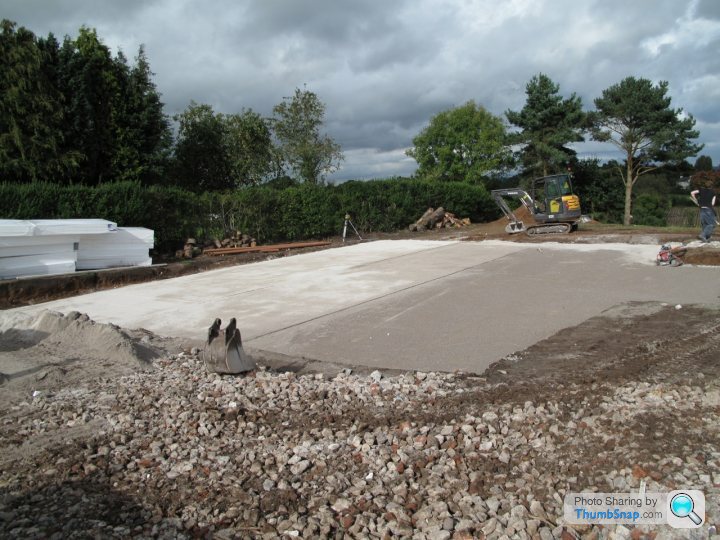
Two of the key features of the build are it’s high levels of insulation and its air-tightness. To put the level of air-tightness into perspective let’s compare it to standard UK Building Regulations.
Part L1A of the ‘regs’ state that any new dwellings are tested for air tightness by using a method known as a ‘blower door test’ in accordance with BS EN 13829. The measurement is taken by blowing air into the house via a particular door that is mounted in the main entrance. Part L1A requires an air tightness of maximum 10 m3/hr/m2 air loss at a pressure of 50 Pa. Standard good practice for air tightness testing in the UK is a maximum of 7 m3/hr/m2.
We are building to Passiv standards and the measure they use is in air changes per hour (ACH). A house built to Passiv standards requires no more than 0.6ACH and that’s what we are aiming for.
There isn’t really a direct way to convert from m3/hr/m2 to ACH as it depends on volume and floor area, but a reasonable finger-in-the-air would be to say that Part L1A is looking for around 7-10ACH. That’s like leaving a door wide open!
So next time your builder says he’s building to the regs, go and find another builder. Or more fairly, another build method.
Every time you put a hole in the structure you compromise its air-tightness. Water, electricity, gas, phone etc. all need to get into the house so how best to do this? Aside from the gas which must go straight in (though the wall) everything else can and will come up through the slab in ducts. The ducts still need sealing and insulating, but that’s a relatively trivial job.
What isn’t trivial though is working out where you want everything to come through the slab and then actually doing it. Accurately. Hence the chat to confirm everything. We’ve changed a few things from my original ideas (“I spent bloody ages working all that out, I’m not changing it now!”) but I’m going with advice based on past experience. Obviously I’m assuming that experience is Good Experience and not repeated carnage, but I’ll be honest and say I daren’t ask! Sometimes it’s good (not) to talk.
Day 2 saw the start of the insulation going down and the first cock-up.
The surveyor had previously set-out the slab perimeter with steel pins but it seems these had been interpreted as something the groundworkers had left in (for a laugh?). I’m not quite sure how you could possibly jump to that conclusion but anyway, they were largely ignored, moved or squashed. Fortunately, 3 were still in-tact so rather than just playing dot-to-dot with a bit of Extruded Polystyrene (EPS) it looks like they’ve got a lot more work to do to ensure it’s all in the right position. I know it’ll be right in the end, but it is more than a bit annoying.
Anyway, end of my day 2 (they were still there way after 6pm) and a couple of photos of some of the EPS waiting to be positioned.
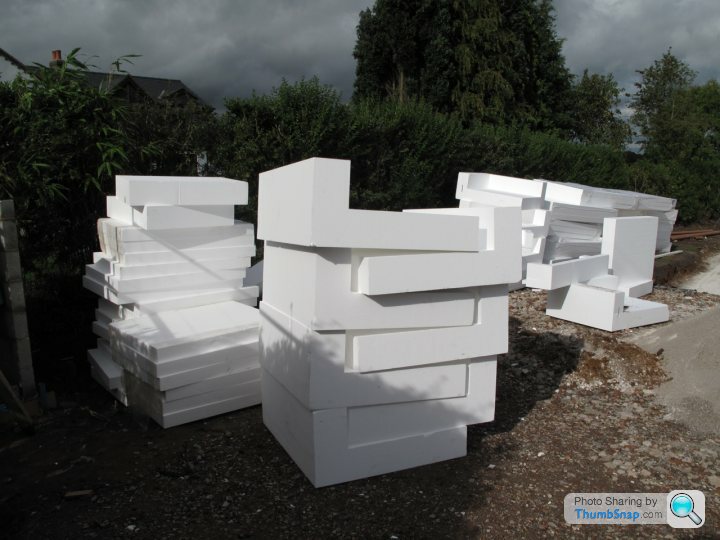
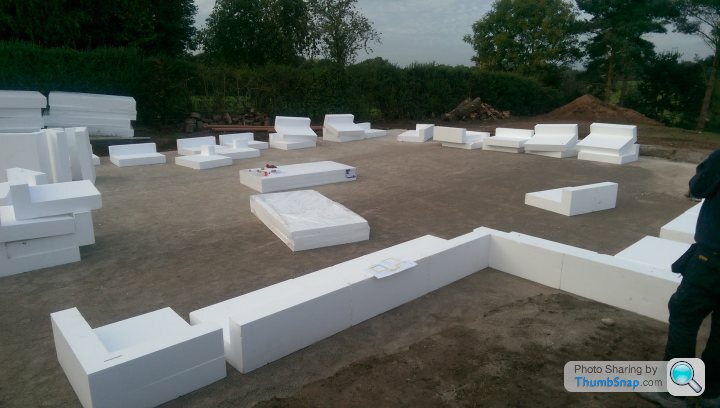
https://selfbuildnoviceblog.wordpress.com
Due to traffic issues on the way over to site on the first day the guys that are doing the slab were delayed by an hour or so, so we had our own little Operation Stack. First one in was a delivery of ‘dust’ – blinding material on top of which the insulation will sit. The driver (a really nice guy) was pretty patient waiting for them to turn up but in the end I just told him to dump it – just not in the hole!
The second lorry was waiting to deliver the insulation itself. I think this driver was quite happy to wait though and jumped straight back in his cab to brew up!
So, the first day was spent getting this ‘dust’ levelled on the slab to a thickness of 50mm. It was pretty slow going (2 guys) but they were very thorough. You can just about see a couple of the battens laid on the slab that they used to help set the levels (with the help of a theodolite). Due to the late start they were off site about 6:30-7:00pm and I think they would have stayed later if it hadn’t started to go dark.

Two of the key features of the build are it’s high levels of insulation and its air-tightness. To put the level of air-tightness into perspective let’s compare it to standard UK Building Regulations.
Part L1A of the ‘regs’ state that any new dwellings are tested for air tightness by using a method known as a ‘blower door test’ in accordance with BS EN 13829. The measurement is taken by blowing air into the house via a particular door that is mounted in the main entrance. Part L1A requires an air tightness of maximum 10 m3/hr/m2 air loss at a pressure of 50 Pa. Standard good practice for air tightness testing in the UK is a maximum of 7 m3/hr/m2.
We are building to Passiv standards and the measure they use is in air changes per hour (ACH). A house built to Passiv standards requires no more than 0.6ACH and that’s what we are aiming for.
There isn’t really a direct way to convert from m3/hr/m2 to ACH as it depends on volume and floor area, but a reasonable finger-in-the-air would be to say that Part L1A is looking for around 7-10ACH. That’s like leaving a door wide open!
So next time your builder says he’s building to the regs, go and find another builder. Or more fairly, another build method.
Every time you put a hole in the structure you compromise its air-tightness. Water, electricity, gas, phone etc. all need to get into the house so how best to do this? Aside from the gas which must go straight in (though the wall) everything else can and will come up through the slab in ducts. The ducts still need sealing and insulating, but that’s a relatively trivial job.
What isn’t trivial though is working out where you want everything to come through the slab and then actually doing it. Accurately. Hence the chat to confirm everything. We’ve changed a few things from my original ideas (“I spent bloody ages working all that out, I’m not changing it now!”) but I’m going with advice based on past experience. Obviously I’m assuming that experience is Good Experience and not repeated carnage, but I’ll be honest and say I daren’t ask! Sometimes it’s good (not) to talk.
Day 2 saw the start of the insulation going down and the first cock-up.
The surveyor had previously set-out the slab perimeter with steel pins but it seems these had been interpreted as something the groundworkers had left in (for a laugh?). I’m not quite sure how you could possibly jump to that conclusion but anyway, they were largely ignored, moved or squashed. Fortunately, 3 were still in-tact so rather than just playing dot-to-dot with a bit of Extruded Polystyrene (EPS) it looks like they’ve got a lot more work to do to ensure it’s all in the right position. I know it’ll be right in the end, but it is more than a bit annoying.
Anyway, end of my day 2 (they were still there way after 6pm) and a couple of photos of some of the EPS waiting to be positioned.


Edited by worldwidewebs on Tuesday 27th September 21:17
Another update to https://selfbuildnoviceblog.wordpress.com
Well, by now I was expecting to be able to say the slab was finished and the timber frame was just starting to go up. No prizes for guessing that’s not what’s happened.
I don't want to copy/paste the entire blog but here are a few photos to whet the appetite...
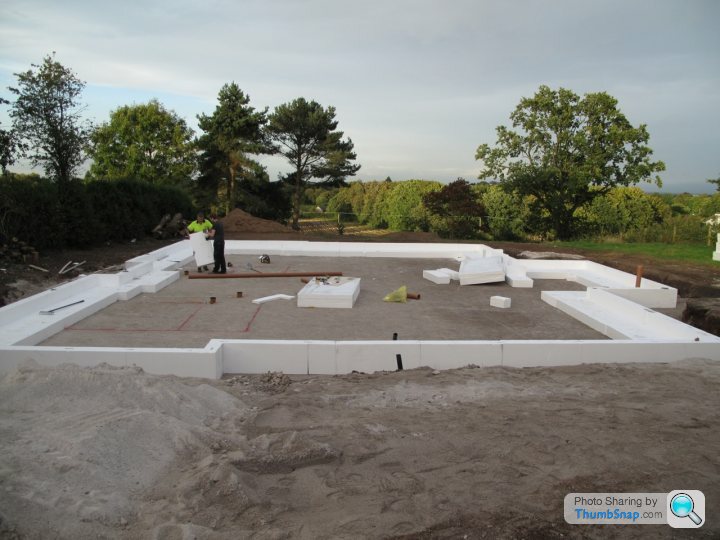
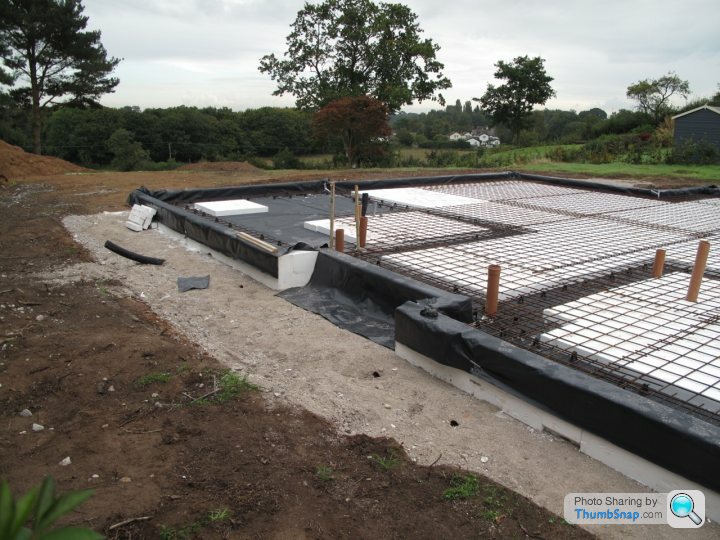


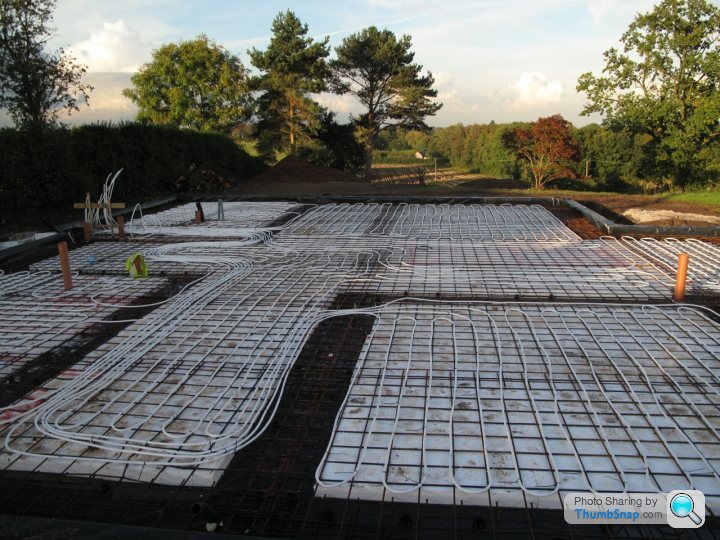
Well, by now I was expecting to be able to say the slab was finished and the timber frame was just starting to go up. No prizes for guessing that’s not what’s happened.
I don't want to copy/paste the entire blog but here are a few photos to whet the appetite...





Has your builder done air-tightness before?
What's the site supervision going to be like?
Will your builder (or someone else) be keeping a *really* close eye on how things are done?
First step: convince people to read the drawings (or have the drawings explained to them)!
I make these points from watching the performance of an unnamed development of "airtight" houses go badly wrong because none of the subbies cared enough to look at any drawings, let alone change the way they'd done the work on all the past jobs...
Supervision is key to these types of builds.
What's the site supervision going to be like?
Will your builder (or someone else) be keeping a *really* close eye on how things are done?
First step: convince people to read the drawings (or have the drawings explained to them)!
I make these points from watching the performance of an unnamed development of "airtight" houses go badly wrong because none of the subbies cared enough to look at any drawings, let alone change the way they'd done the work on all the past jobs...
Supervision is key to these types of builds.
dxg said:
Has your builder done air-tightness before?
Yes, many and just one of the reasons I went with them. Actually, the timber frame company are responsible for all this, including the air tightness test itself and one of the last payments to them is actually dependent on the test passing an agreed level of air-tightness. dxg said:
Has your builder done air-tightness before?
I make these points from watching the performance of an unnamed development of "airtight" houses go badly wrong because none of the subbies cared enough to look at any drawings, let alone change the way they'd done the work on all the past jobs...
Yes, they're fair and valid points. I've tried to be as careful as I can be in choosing my trades (some I've used previously, some recommended) but I know there is going to be a level of law-laying that will be going onI make these points from watching the performance of an unnamed development of "airtight" houses go badly wrong because none of the subbies cared enough to look at any drawings, let alone change the way they'd done the work on all the past jobs...
Great build.
Will the underfloor pipes be held under pressure when the concretes poured, I'm halfway through laying a 4 manifold system and have the pipes fully pressurized with water to approx 6bar and it stays like that for at least 21 days while the screed cures and any heat can be introduced to the system.
Will the underfloor pipes be held under pressure when the concretes poured, I'm halfway through laying a 4 manifold system and have the pipes fully pressurized with water to approx 6bar and it stays like that for at least 21 days while the screed cures and any heat can be introduced to the system.
souper said:
Great build.
Will the underfloor pipes be held under pressure when the concretes poured, I'm halfway through laying a 4 manifold system and have the pipes fully pressurized with water to approx 6bar and it stays like that for at least 21 days while the screed cures and any heat can be introduced to the system.
No, I don't think so - none are connected to anything at the momentWill the underfloor pipes be held under pressure when the concretes poured, I'm halfway through laying a 4 manifold system and have the pipes fully pressurized with water to approx 6bar and it stays like that for at least 21 days while the screed cures and any heat can be introduced to the system.
worldwidewebs said:
No, I don't think so - none are connected to anything at the moment
The gist of what I've been told is that the pipes are keep under pressure for two reasons, one so that there isn't a leak or fracture in the pipe runs and it holds its pressure so you don't have to dig up to find a leak, the second is that concrete/screed gives off heat when curing, the pressurized pipes keep the pipes from shrinking under the weight of the concrete and when the system is in use the pipes are going to be around 4-6 bar, pre pressurizing stops concrete voids around the pipes and helps against fracturing when the slab heats/cools or via general expansion/contraction.How many do the pressurizing!? I don't know but I did it just to be safe.
souper said:
The gist of what I've been told is that the pipes are keep under pressure for two reasons, one so that there isn't a leak or fracture in the pipe runs and it holds its pressure so you don't have to dig up to find a leak, the second is that concrete/screed gives off heat when curing, the pressurized pipes keep the pipes from shrinking under the weight of the concrete and when the system is in use the pipes are going to be around 4-6 bar, pre pressurizing stops concrete voids around the pipes and helps against fracturing when the slab heats/cools or via general expansion/contraction.
How many do the pressurizing!? I don't know but I did it just to be safe.
When in use, under floor heating pipes are around 1.5/ 2 bar.How many do the pressurizing!? I don't know but I did it just to be safe.
The slab is done. Finally.
The day started overcast but not too bad and when I turned up on site at about 6pm the concrete had been poured and the panning to level the slab had commenced. Then the first few drops of rain came down and it started to go dark. Then it REALLY started to rain. The weather apps showed clear skies. My mind drifted back to Michael Fish and 1987 and we went to the pub.
Brendan was back on site at 3am (yes, really!) to do what he could with it. As a client we were fortunate on 3 levels: he was prepared to come out then to ensure it was all ok; one set of neighbours were on holiday; the other set of neighbours were beyond understanding and didn’t complain (they were asked prior to it though).
The rain significantly slowed the concrete going ‘off’ and it was almost 3pm on Friday before Brendan had finished. The slab perhaps doesn’t have as good a finish as it might, but it is flat and level (or as good as needs to be)
There are a couple of issues that need to be resolved, 1 more significant than the other, but both will be resolved in the next few weeks.
In two weeks time the timber frame erection will start
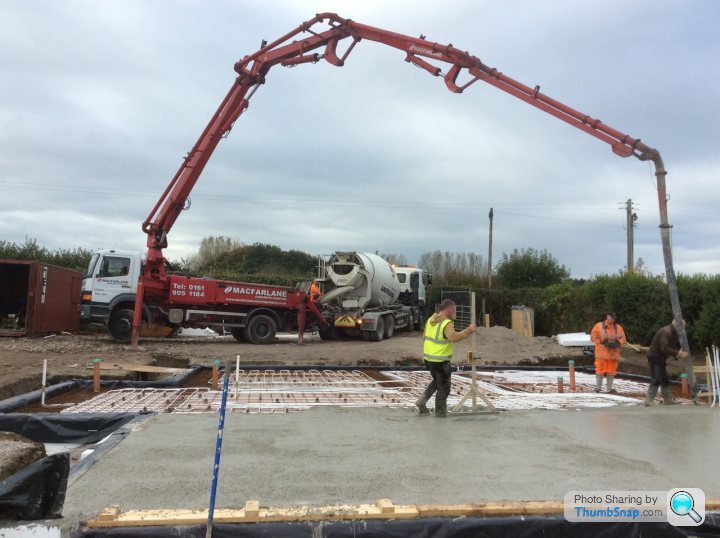
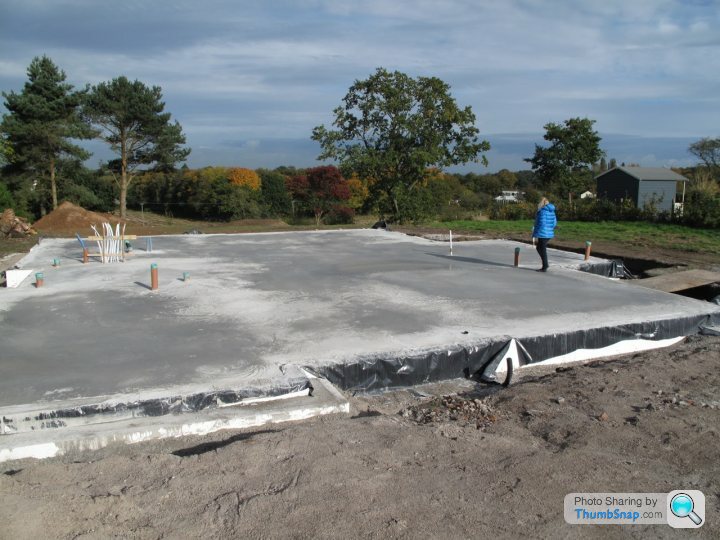
There's a bit more detail and photos on the blog: https://selfbuildnoviceblog.wordpress.com
The day started overcast but not too bad and when I turned up on site at about 6pm the concrete had been poured and the panning to level the slab had commenced. Then the first few drops of rain came down and it started to go dark. Then it REALLY started to rain. The weather apps showed clear skies. My mind drifted back to Michael Fish and 1987 and we went to the pub.
Brendan was back on site at 3am (yes, really!) to do what he could with it. As a client we were fortunate on 3 levels: he was prepared to come out then to ensure it was all ok; one set of neighbours were on holiday; the other set of neighbours were beyond understanding and didn’t complain (they were asked prior to it though).
The rain significantly slowed the concrete going ‘off’ and it was almost 3pm on Friday before Brendan had finished. The slab perhaps doesn’t have as good a finish as it might, but it is flat and level (or as good as needs to be)
There are a couple of issues that need to be resolved, 1 more significant than the other, but both will be resolved in the next few weeks.
In two weeks time the timber frame erection will start



There's a bit more detail and photos on the blog: https://selfbuildnoviceblog.wordpress.com
Gassing Station | Homes, Gardens and DIY | Top of Page | What's New | My Stuff







